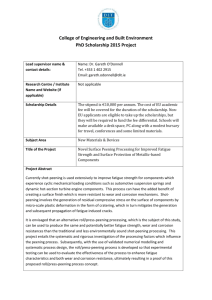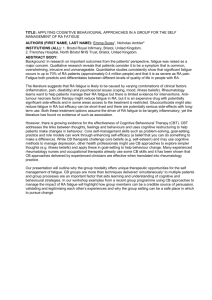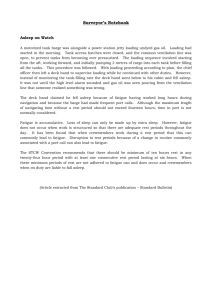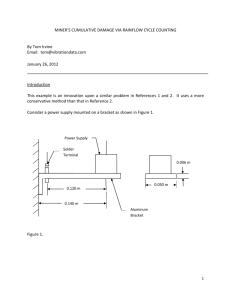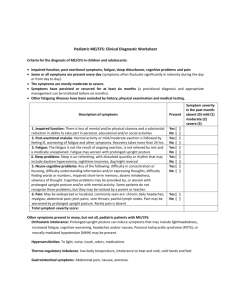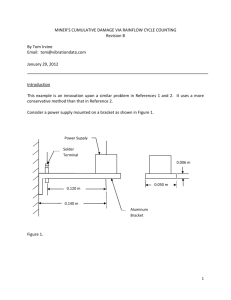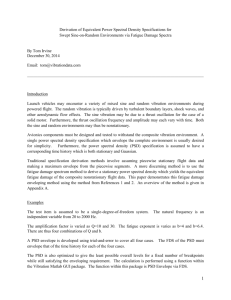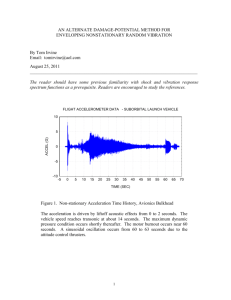A Fatigue Damage Spectrum Method for Comparing Power Spectral
advertisement
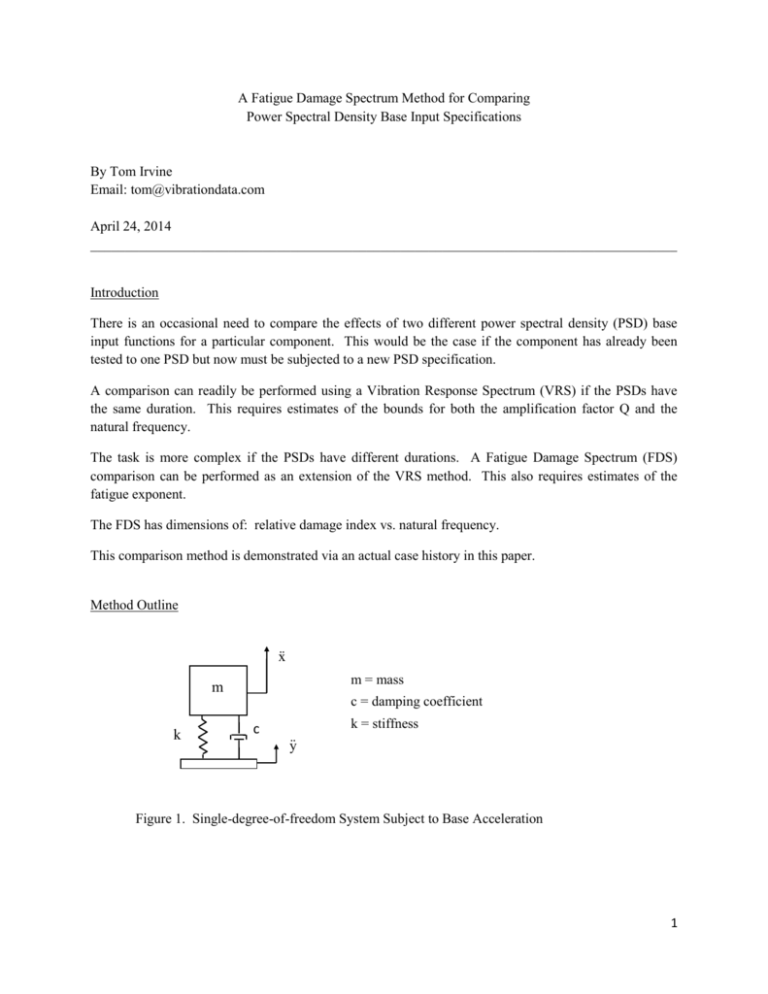
A Fatigue Damage Spectrum Method for Comparing Power Spectral Density Base Input Specifications By Tom Irvine Email: tom@vibrationdata.com April 24, 2014 _____________________________________________________________________________________ Introduction There is an occasional need to compare the effects of two different power spectral density (PSD) base input functions for a particular component. This would be the case if the component has already been tested to one PSD but now must be subjected to a new PSD specification. A comparison can readily be performed using a Vibration Response Spectrum (VRS) if the PSDs have the same duration. This requires estimates of the bounds for both the amplification factor Q and the natural frequency. The task is more complex if the PSDs have different durations. A Fatigue Damage Spectrum (FDS) comparison can be performed as an extension of the VRS method. This also requires estimates of the fatigue exponent. The FDS has dimensions of: relative damage index vs. natural frequency. This comparison method is demonstrated via an actual case history in this paper. Method Outline x m = mass m c = damping coefficient k k = stiffness c y Figure 1. Single-degree-of-freedom System Subject to Base Acceleration 1 The component is assumed to behave as a single-degree-of-freedom system. The component has three independent variables for the fatigue damage calculation: 1. Natural frequency 2. Amplification factor Q 3. Material fatigue exponent b Ideally, each of these three parameters is precisely known, but bounds must be estimated otherwise. The natural frequencies should be modeled in, say, 1/24th octave steps between its estimated bounds, if the exact value is unknown. Simple high and low estimate pairs may be used for the both the amplification and fatigue exponent as needed. A response PSD must be calculated for each input PSD and for each natural frequency and amplification factor of interest, using the method in Reference 1. Next, the semi-empirical Dirlik method can be used to calculate the cumulative histogram of the acceleration response cycles, as shown in References 2 and 3. The resulting histogram is approximately the same as would be obtained by performing a rainflow cycle count in the time domain, per the method in Reference 4 and as shown in Reference 5. Finally, the fatigue damage spectrum is calculated for the set of response time histories using the b values and the method in Appendix A. 2 Case History A component was previously tested to the PSD in Table 1. A new specification is given in Table 2. Is retesting necessary? Table 1. Power Spectral Density, As Tested, 25 GRMS Overall, 1 hour/axis Frequency Accel (Hz) (G^2/Hz) 15 0.04 47.26 0.04 300 0.47 1000 0.47 2000 0.118 Table 2. Power Spectral Density, New Specification, 4.6 GRMS Overall, 5 hours/axis Frequency Accel (Hz) (G^2/Hz) 10 0.04 40 0.04 2000 0.006 3 POWER SPECTRAL DENSITY 1 New Spec, 4.6 GRMS As Tested, 25 GRMS 2 ACCEL (G /Hz) 0.1 0.01 0.001 10 100 1000 2000 FREQUENCY (Hz) Figure 2. The two PSD levels are shown in Figure 2. 4 Analysis Results Each PSD was applied as a base input to a single-degree-of-freedom system with independent variables: natural frequency, damping, and fatigue exponent. The damping is represented in terms of the amplification factor Q. The material fatigue exponent is b. This is the slope of the S-N curve. The Q value is unknown, so values of 10 and 50 were used as bound estimates. The fatigue exponent is also unknown, so values of 4 and 9 were used as bound estimates. Thus there were four total permutations of the Q and b cases. The results are given in terms of Fatigue Damage Spectra in Figures 3 through 4. The results show that the “As Tested” level envelops the “New Specification” as long as the component natural frequency is greater than 70 Hz. Note that Steinberg wrote in Reference 6: Most circuit boards appear to have their fundamental resonant frequencies between about 200 and 300 Hz when used in military electronic systems. The fundamental frequency can be even higher in smaller electronics boxes with circuit boards populated by surface mounted parts. 5 FATIGUE DAMAGE SPECTRA 10 Q=10 b=4 16 DAMAGE INDEX New Spec As Tested 10 13 10 10 10 7 10 4 10 70 100 1000 2000 1000 2000 NATURAL FREQUENCY (Hz) Figure 3. FATIGUE DAMAGE SPECTRA 10 Q=10 b=9 27 DAMAGE INDEX New Spec As Tested 10 22 10 17 10 12 10 7 10 50 70 100 NATURAL FREQUENCY (Hz) Figure 4. 6 FATIGUE DAMAGE SPECTRA 10 Q=50 b=4 17 DAMAGE INDEX New Spec As Tested 10 15 10 13 10 11 10 9 10 7 10 70 100 1000 2000 1000 2000 NATURAL FREQUENCY (Hz) Figure 5. FATIGUE DAMAGE SPECTRA 10 Q=50 b=9 30 DAMAGE INDEX New Spec As Tested 10 25 10 20 10 15 10 10 10 70 100 NATURAL FREQUENCY (Hz) Figure 6. 7 References 1. T. Irvine, An Introduction to the Vibration Response Spectrum, Revision D, Vibrationdata, 2009. 2. Halfpenny & Kim, Rainflow Cycle Counting and Acoustic Fatigue Analysis Techniques for Random Loading, 10th RASD International Conference, Southampton, UK, July 2010. 3. Halfpenny, A Frequency Domain Approach for Fatigue Life Estimation from Finite Element Analysis, nCode International Ltd., Sheffield UK. 4. ASTM E 1049-85 (2005) Rainflow Counting Method, 1987. 5. T. Irvine, Experimental Verification of the Dirlik Fatigue Cycle Method, Vibrationdata, 2013. 6. Dave Steinberg, Vibration Analysis for Electronic Equipment, Second Edition, WileyInterscience, New York, 1988. APPENDIX A A relative damage index D can be calculated using m D Ai n i b (A-1) i 1 where Ai is the response amplitude from the rainflow analysis ni is the corresponding number of cycles b is the fatigue exponent Note that the amplitude convention for this paper is (peak-valley)/2. . 8

